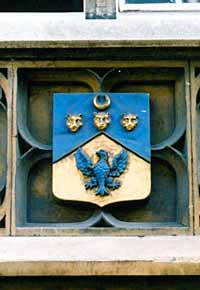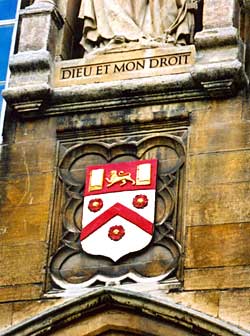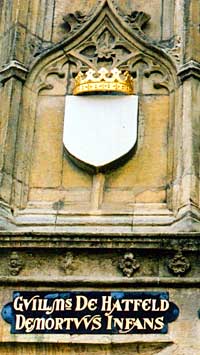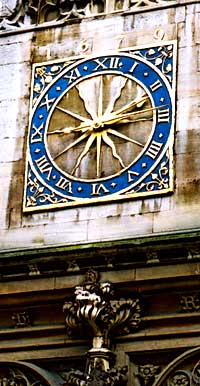O grasses wet with dew, yellow fallen leaves,
Smooth-shadowed waters Milton loved, green banks,
Arched bridges, rooks, and rain-leaved willow-trees,
Stone, serious familiar colleges,
For ever mine.
The figure of a scholar carrying back
Books to the library — absorbed, content,
Seeming as everlasting as the elms
Bark-wrinkled, puddled round their roots, the bells,
And the far shouting in the football fields.
The same since I was born, the same to be
When all my children’s children grow old men.
A Glimpse. Different Days (Hogarth Press, 1928).
This poem, incidentally, illustrates the general movement within the tradition of Wordsworth, for he too had walked a good deal in the Backs and had noted the tendency in the dons to look like the old elms:
men unscoured, grotesque
In character, tricked out like aged trees
Which through the lapse of their infirmity
Gave ready place to any random seed
That chooses to be reared upon their trunks.
The Prelude, III, 542–6

This local colour, however, is only the most superficial mark of Cambridge on these Georgian poets. Much less superficially and accidentally, they moved in harmony with the most active intellectual temper of the place: the temper that was most typical of King’s College and of which E. M. Forster and Virginia Woolf are, in a sense, other literary results. It was made up of rationalism and radicalism, of enlightened optimism about human society, a steady hatred of violence and injustice, a cultivation of all the arts, among which philosophy, ‘moral science’, was not the least. This temper underlies the poetry of Brooke, and even more that of Frances Cornford. But it seems to me to be a slight weakness in both that it merely underlies, that it is only implied, there in the background. A reader of Brooke’s poems would have to be very perceptive indeed to make out that he was an enthusiastic Fabian Socialist who spent a vacation or two actively campaigning for the cause.
It would, of course, be wrong with the Georgians, as with the other groups of ‘Cambridge poets’, to overstress their homegeneity of style and outlook. Though they may look to us, in a very general way, rather alike, they looked very different to each other. In 1908 Brooke wrote this to Edward Marsh:
Mrs. Cornford tried to engage me in a controversy over the book — she and her school. They are known as the Heart-cries, because they believe all poetry ought to be short, simple, naive, and a cry from the heart, the sort of thing an inspired only child might utter if it was in the habit of posing to its elders. They object to my poetry as unreal, affected, complex, ‘literary,’ and full of long words.
Rupert Brooke, A Memoir, Edward Marsh (London, 1918)
This distinction was no doubt a very proper one at the time, but it was even more prophetic of the future. The later history of ‘Cambridge poetry’ could quite well be analysed in these terms. On the one hand, there has been a good deal of personal poetry, simple, relying on a more or less traditional style, and upon a sincerity of lyrical and reflective impulse which might sometimes be called ‘naïve’. Mrs Cornford herself has gone on writing in this way, though in some other latest verse there is a slight movement with the time, to a more ‘modern’ style. And there have been many others too — F. L. Lucas, George Rylands, Frank Kendon, and Franklyn Kidd (the only one who happens to be professionally engaged in that most typical of Cambridge pursuits, ‘natural science’). But they seem rather to be poets than specifically ‘Cambridge poets’. And on the other hand the later periods of high fashion in Cambridge poetry have followed Brooke — or, rather, have far outdistanced him, in being complex, ‘literary’, and full of long words.

The change was, of course, not one confined to Cambridge. It was merely a local reflection of the movement lead by Eliot and Pound. But it was certainly intensified by local conditions. A Faculty of English had come into being in the late 1920s, and it was bound to influence greatly the performance of local writers and the expectations of their readers. It is certainly no part of an English Faculty’s business to make young men into poets; it is much more its business to stop them from trying to be poets, and this it often does with some success. But those who are unstopable are none the less influenced by the methods which have been used to stop them, and they often reflect closely the literary tendencies of the Faculty. Very broadly and simply, these have been a constant insistence on the importance of the Elizabethans and the Metaphysicals; and as a consequence, not altogether deliberate, of this insistence there has been a lack of enthusiasm for the Romantics and their successors in the nineteenth century When a literary society started in St John’s College in 1929, search was made for its name among the College poets; Wordsworth was not considered to be the right man, and Nashe was the one chosen. And when Herbert Read, regarded as a leader of the ‘modern’ movement, chose to give his Clark Lectures in 1930 on Wordsworth, he was generally thought to be doing a very strange and paradoxical thing.
This Elizabethan-Metaphysical fashion naturally dominated the next period of ‘Cambridge poetry’ and marked it off sharply, at any rate in style, from the Georgians. Its most characteristic writer was beyond any doubt William Empson. His poetry has even less of the superficial local colouring than that of Brooke: his sole reference to the Cambridge landscape is this:
The creepiness of Cambridge scenery,
In the same way, consists in having trees,
And never, from any view-point, looking ‘wooded,’ —
What once was virgin forest, in safe hands.
But here the opposite disorder charms;
What was planned as airy and wide open space
Grown cramped, seems stifled here under traditions,
(Traditor), their chosen proportions lost . . .
[ Note: ] Sleeping Out in the Cloister. The Venture, June, 1930. Amateurs of literary comparisons may like to put this poem with Brooke’s Sleeping Out: Full Moon. There could hardly be wider differences in the use of a similar experience.
But in all other ways he seemed, at the time (and in retrospect too) to be exactly and admirably the expression of the time, as well as being almost violently himself. The literary atmosphere was set chiefly by I.A. Richards, whose lectures on practical criticism were drawing vast, almost evangelical audiences and educating them in the reading of ‘difficult’ poetry, in the understanding of images in which intellectual and emotive elements were fused. Empson was able to give this fashion a creative turn, partly because he just happened to be able to do it, but partly, perhaps, because he had read mathematics (very creditably) before he took the English Tripos. ‘Long words’ and scientific notions that others had to garner carefully and consciously for their images to him came entirely naturally: they were familiar to him not merely because he wanted to use them in poetry — he used them because they were already familiar. And the impact of his poetry was strengthened by his criticism, for preliminary studies of the book that later came out as Seven Types of Ambiguity were being published in the same magazines that published his poetry. Taken together, they established a powerful and coherent, if limited, literary position.

So much was clear on the surface. But there were deeper resonances with the spirit of the place and age that escaped notice, because he himself played them down, partly from what looked like a fastidious sense of intellectual privacy, partly through a habit of irony often carried to the point of mannerism. But he was, after all. President of the Heretics, the Cambridge society that most obviously embodied the radical-rationalist tradition of the pre-war days. By training and intellectual capacity, moreover, he was aware, in a much less dilettante manner than most of his contemporaries, of the fact that G.E. Moore and Wittgenstein were lecturing in the University, as well as I.A. Richards. So that both his poetry and his criticism, though almost deceptively purely ‘literary’, moved in a real intellectual and moral world, clearly grasped, even when the grasp was ironically concealed. The most obvious outward sign of a serious concern for the conduct of life was his capacity for mordant social observation, for pin-pointing the more significant quirks and follies of human behaviour. And closely allied with this was a superb command of colloquial English, so that among the ‘difficult’ lines and the scientific images there were astonishing pieces of simply musical writing.
There were other poets besides Empson, enough to support two magazines, The Venture, which was inclined to be traditional and as it were neo-Georgian, and Experiment, which was aggressively modern: it once contributed a section to Transition. Most of those who wrote in them have now (so far as I know) given up writing poetry, though they write a great deal of prose, and of the few that go on being poets, still fewer retain any distinctive mark of their Cambridge period. Ronald Bottrall, for example, and Kathleen Raine and J.M. Reeves all belong to this period of Cambridge poetry, in the merely chronological sense, but they are all, in different ways, so different from Empson that his overwhelming presence can hardly have been helpful to them: they seem to have become much more themselves when they got away from Cambridge.
Looking back now on that period, it seems to me that there was one aspect of Empson’s attitude that had a powerful negative effect and played some part in the immediate history of ‘Cambridge poetry’ after him. His irony and apparent detachment rather discouraged straightforward commitment to the political interests that were becoming so powerful at the time: it was the period of mass unemployment, of Manchuria, the sabotage of the League of Nations, the rise of Hitler. Very much later he added a note to his poem China which, characteristically in a bracket, is equally characteristic of this side of him: ‘I cut out an intervening verse about Russia, who is an important influence on the country now, because it seemed no use pretending I had anything to say about proletarianism.’ (Notes to China in The Gathering Storm. Faber and Faber, 1940.)
‘No use pretending’ — certainly not. But it left Cambridge poetry at a disadvantage in the 30s, when the Oxford poets, Auden and Spender, had so much to say about proletarianism. So completely did they take over the forefront of poetic fashion that the young men in Cambridge who might otherwise have been followers of Empson became Oxford poets instead. Thus Charles Madge:
But there waited for me in the summer morning,
Auden, fiercely. I read, shuddered and knew
And all the world’s stationary things
In silence moved to take up new positions.
New Country, Ed. Michael Roberts, Hogarth Press, 1933, p. 231
The young men of that vintage who wrote poetry, then, were rather followers of Auden than of Empson: Empson’s own splendidly ribald comment was his Smack at Auden.
But the ablest and best of them were no longer devoted to poetry with the same exclusiveness as before. If they wrote, it was in odd moments and conscious that their real business was direct political activity. Of this period the outstanding representative was John Cornford. In an article in Cambridge Left, 1934, he joined in a controversy that had been going on somewhere between Stephen Spender and Charles Madge about ‘the objective participation of the writer in the class struggle.’ Cornford accused Spender of taking up the typically ‘bourgeois’ position of an ‘impartial observer’, and gave moderate approval to some formulations by Madge which demanded of the poet a more active participation in things. Cornford’s own theory went to the limit in this direction: ‘There can be no doubt that the Future is with the revolutionary participator and not the “impartial observer”, nor the romantic-Utopian idealist.’ And in practice he also went to the limit, to death at the head of a machine-gun section in Spain. He wrote some poetry, and the poems from Spain certainly ought to be remembered; but Cornford himself ought to be remembered for something besides them. His personality and his death have a certain symbolic significance of their own. He was not, of course, the only Cambridge man who died in Spain: but no doubt Sidney was not the sole English casualty at Zutphen.

Cambridge ended the 30s, then, and entered the war years with its best energies and its most outstanding young man already expended. The less powerful but melodious and pleasing poet of the time was Nicholas Moore, speaking partly in the Cambridge style, but more in his own, with some faint surrealist whispers behind the arras. I have been told by someone who was an undergraduate then that at Cambridge they were rather conscious of not having anyone quite like Sidney Keyes at Oxford.
After the war there was plenty of poetry in the town. Many of the returning warriors brought it up with them, already written. In this, as in most other things, they were more inclined to teach than to learn, and with good reason, for their education was already advanced, and by methods far more powerful than a university can employ. It was only when they had gone down that a more genuinely local revival of poetry was possible, and its presence was marked, in the customary manner, by the publication of a book of Poetry from Cambridge in I952 — the first volume of its kind since the two Cambridge Poetries of 1920 and 1930.*
* The collections of 1929 and 1930 were published by the Hogarth
Press, which also published, in 1931, a slim volume of Cambridge women’s
poetry. Poetry from Cambridge is published by the Fortune Press.
In it — so far as generalizations are possible — the typical local literary influences are still there: they are even intensified. The Metaphysicals and the Elizabethans are clearly still read with devotion. Indeed they not only furnish out some of the manner, they provide occasional matter too, as Thom Gunn’s Mirror for Poets:
Yet the historians tell us, life meant less
It was a violent time, and evil-smelling.
Jonson howled ‘Hell’s a grammar-school to this’,
But found renunciation well worth telling.
Winnowing with his flail of comedy
He showed coherence in society.
There’s a certain nostalgia here, as there might well be, for it would not appear that these poets find much coherence in their own society. It rather looks as though the intellectual temper of radicalism and rationalism that supported the Georgians, gave substance to Empson’s poetry later, and then turned to the passionate Communism of the 30s, has melted away somewhere and that nothing has quite taken its place. There has, of course, been a kind of vague undogmatic religious revival among the young in Cambridge in recent years — among some of the old too. But its traces are not to be found in this volume of poems. Where they touch religion, it is with a sort of nostalgic agnosticism, as in Gunn’s Lazarus not Raised:
Abruptly the corpse blinked and shook his head
Then sank again, sliding without a trace
From sight, to take slime on the deepest bed
Of vacancy. He had chosen to stay dead,
The scheduled miracle did not take place.
Nothing else changed. I saw somebody peer
Stooping, into the oblong box of space.
His friends had done their best: without such fear
Without that terrified awakening glare
The scheduled miracle would have taken place.
(In quoting only two verses from a longer poem, I do it wrong. But the
whole can be read, and should be.)
Politics too is curiously represented. While the Union generally votes for Tory motions, there is no positive Toryism in this verse. The few references to politics are rather sadly bemused — and again nostalgic, like this one by John Mander:
It was always them
It did not seem important at the time:
We gave them pity, when they wanted gold,
We could not help it: we were never told.
We’d lost our glasses, so we could not see;
We went home early from the Pantomime —
It did not seem important at the time.
We walked away: it was not our concern.
There may have been some fruit upon the Tree:
We’d lost our glasses, so we could not see.
We could not help it: we were never told.
We heard a shot: the guards looked very stern.
We walked away: it was not our concern.
We could not help it: we were never told.
We think there were some rumours of a crime,
We’d lost our glasses, so we could not see.
We walked away: it was not our concern.
The streets were dark and it was very cold.
It did not seem important at the time.
And here and there, mingled with these bewilderments, is something of that more widely prevalent nostalgia that hankers after elegance, archaic dandyism — a touch of Teddy-boy poetry, nicely done in this portrait by John Coleman:
Mrs Lucretia Dax
And if you say her thoughts are butterflies,
Yellowing here and there white garden walls,
And if you say her hands visit her eyes
Like withered maiden ladies paying calls,
And if you say her blue-veined throat tells lies
Of beaux and furbelows, ancestral halls
Where Patti sang for supper, her surprise
Will be the brushwork on originals.
Because this lady, blackened like a knife,
Had silver once, and cannot quite forget it,
Because this lady paid her rent on life
Long years ago and cannot now sub-let it,
Do not neglect her utterly: a wife,
She both gave pleasure, and knew where to get it.
This proneness to various kinds of nostalgia, to the deliberately drab exploration of disappointment, disillusionment and ‘lostness’ is perhaps inevitable in a place that has, for the time being, slackened its moral and intellectual tone, compromised away the radical-rational temper that was its last positive and effective achievement. In a city of many and faintly lost causes, where the most noticeable spire is a ghastly nightmare of a thing belonging to a Catholic Church somewhere up by the station, these young men are at least being honest about their situation: ‘they were never told’.
|
